Chronique:Canon Fodder - Lore of the Jungle
ISSUE 127
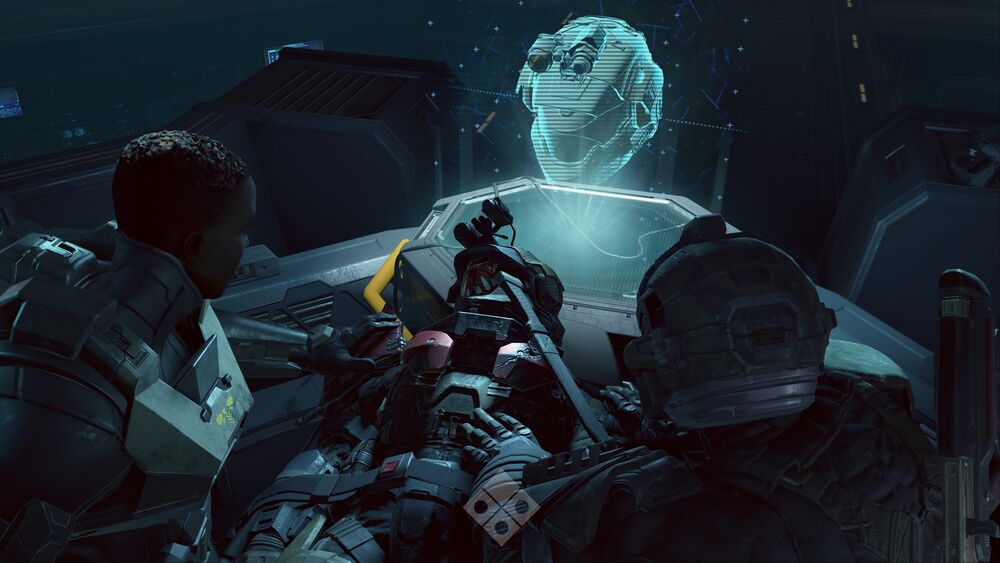
Alex Wakeford
5/4/2022
Hello there!
Welcome back, fiction fans. We have a veritable feast of lore for you today!
The Halo Encyclopedia has arrived, Season 2 of Halo Infinite has dropped out of slipspace and brought a host of new story elements to the game, we've got a deep dive into part of Halo Infinite's campaign, and more.
Let's get right into it...
Encyclopedia Entrée[modifier le wikicode]
The Halo Encyclopedia is here!
At last, this towering tome of 488 pages covering over two decades of storytelling and lore can be yours to be used for the purposes of education or home defense.
Pick up your own copy of the Halo Encyclopedia here or secure the impressive Deluxe Edition here, elegantly enshrined in a mysterious Forerunner cylix slipcase.
Additionally, the digital edition will be released on May 10, which you can grab here.
I was fortunate enough to have the opportunity to sit down with the authors on our amazing Franchise team to discuss all things Halo lore around the Halo Encyclopedia and get a deeper understanding of how this project came to be—you can watch that in the video below.
And, of course, there ain't no nouns quite as good as Halo nouns! In concert with the release of the encyclopedia itself, our Glossary lives on Halo Waypoint as a centralized place to help folks get to grips with some of the terminology of the Halo universe.
Check out the Halo Encyclopedia Glossary page here.
We will be doing a full issue on the Halo Encyclopedia next month, which you definitely won't want to miss!
That Lone Wolf Stuff[modifier le wikicode]
I've seen your file, even the parts the ONI censors didn't want me to. I'm glad to have your skillset. And that lone wolf stuff? We actually need you to bring it all, Spartan...
Spartan Commander Agryna has enlisted a new generation of Spartans and is preparing them to face the Banished—and perhaps even more dangerous foes.
Season 2 of Halo Infinite has landed and that gives us a lot to cover, as it's not just a swath of new gameplay and cosmetic content that's arrived but new story content as well!
This is the beginning of--
//EMERGENCY//
//BREACH DETECTED//
--an ongoing, multi-season storyline that centers your multiplayer Spartan. For the full briefing on all that entails, give our Season 2 launch blog a look!
When we launched the Halo Infinite multiplayer experience in November last year, players were introduced to Laurette Agryna through the lens of her civilian past and her present role as the Spartan Commander of the Avery J. Johnson Academy of Military Science.
Jumping into the Academy itself not only taught players the fundamentals of Halo's gameplay, but was also framed within the broader context of the story. Brought to a classified frontier world, you are among a new generation of SPARTAN-IV super-soldiers following the destruction of Laconia Station and the disappearance of both the UNSC Infinity and Zeta Halo.
There are wolves amongst the stars and many unanswered questions about the state of the galaxy, but one thing is clear: Spartans are going to be the tip of the spear as humanity regroups and rebuilds in order to face what's out there.
As Commander Agryna says at the end of the Academy tutorial, which takes place mid-December 2559:
Spartan Commander Laurette Agryna (Halo Infinite, Academy)
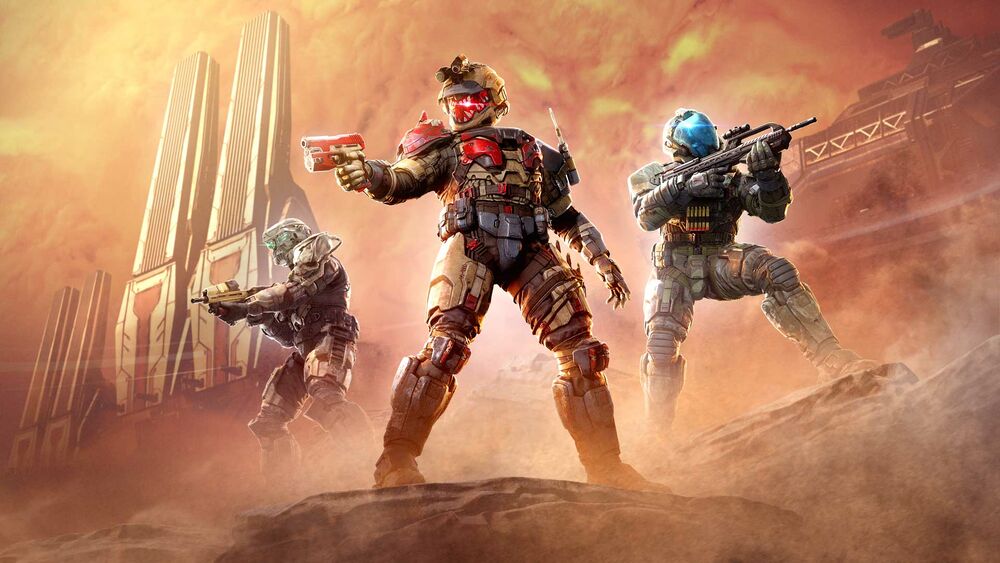
Not every Spartan operation benefits from more Mjolnir-shod boots on the ground. Headhunter assassinations, deep reconnaissance, information sanitization, and “off-the-books” black ops require Spartans with a very particular set of skills and minimal signature in the conflict zone.
The recent conflicts have also introduced a new factor: Spartans who find themselves completely cut off from the UNSC, forced to scrounge for ammo, food, and power cells deep behind enemy lines. With luck, they can link up with other survivors, creating ad-hoc packs bound by their Spartan training and indomitable drive to achieve victory in humanity's darkest hour.
And that's where Spartans Hieu Dinh and Sigrid Eklund come in…
SPARTAN SIGRID EKLUND
Sigrid Eklund honed her calm and reserved demeanor during her service as a UNSC Army Ranger supporting human resistance groups on Covenant-occupied words. As a Spartan, these attributes—as well as Eklund's deeply strategic mind—are invaluable assets in the current conflict against the Banished and their rapidly expanding influence.
A quiet professional, adept at both covert surveillance and kinetic strikes, Eklund has adopted the STRIBOG helmet as the core of her loadout, making use of its extensive reconnaissance capabilities to direct precious UNSC combat assets to the right place at the right time.
Sigrid Eklund honed her calm and reserved demeanor during her service as a UNSC Army Ranger supporting human resistance groups on Covenant-occupied words. As a Spartan, these attributes—as well as Eklund's deeply strategic mind—are invaluable assets in the current conflict against the Banished and their rapidly expanding influence.
A quiet professional, adept at both covert surveillance and kinetic strikes, Eklund has adopted the STRIBOG helmet as the core of her loadout, making use of its extensive reconnaissance capabilities to direct precious UNSC combat assets to the right place at the right time.
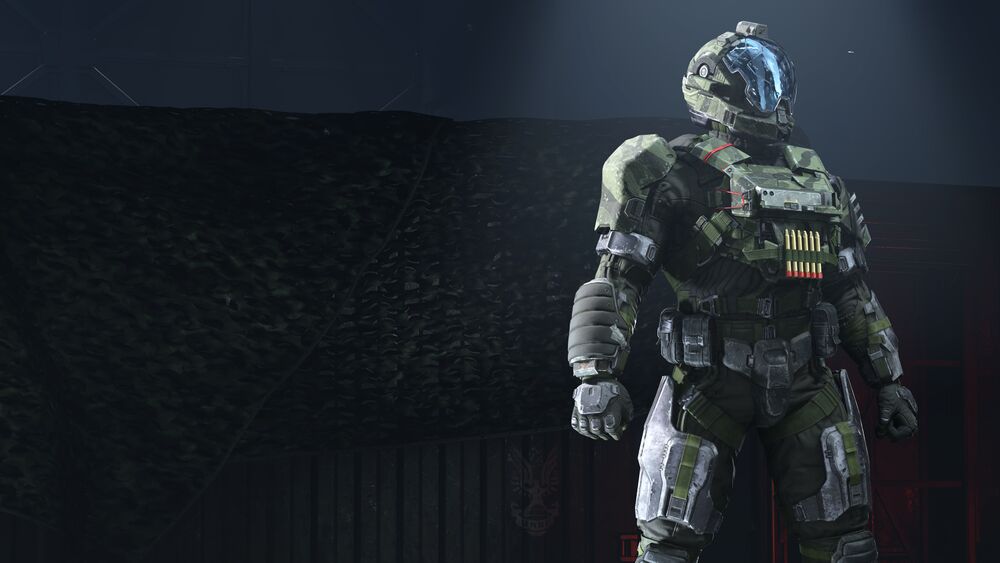
SPARTAN HIEU DINH
Before joining the SPARTAN-IV program, Hieu Dinh was a field analyst with the Office of Naval Intelligence's Section III tasked with capturing and re-purposing Covenant technology. However, these same skills, combined with Dinh's high tolerance for risk and penchant for improvisation, may have just landed him in his most dangerous plight yet.
Spartan Dinh wears a custom ensemble shaped by brutal close-quarters engagements against Banished boarding parties and extermination teams. His helmet is an ARTAIUS model, co-opted from a small run of prototypes originally intended for a new class of combat exoframe.
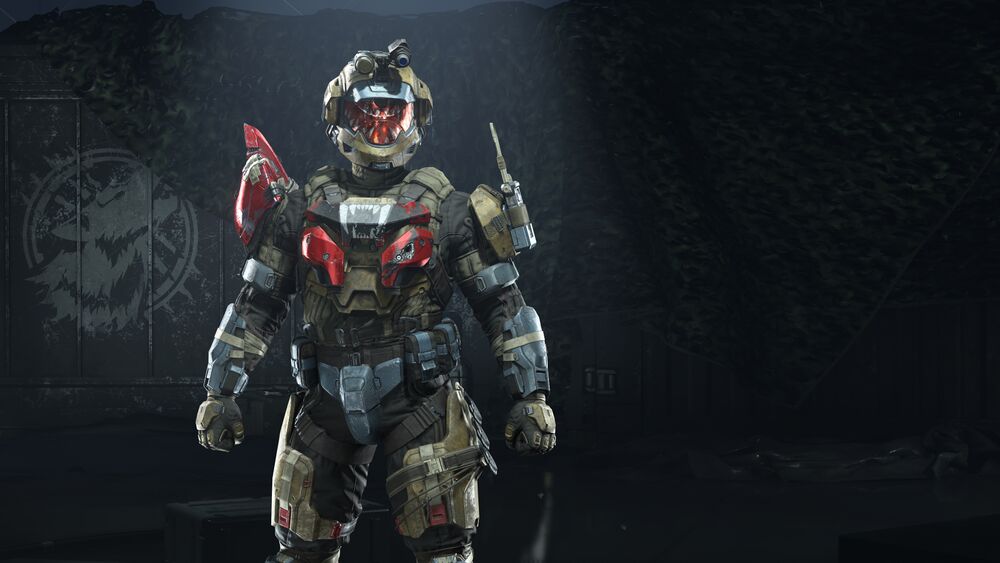
//WARNING: CLASSIFIED INFORMATION FOLLOWS//
IRATUS
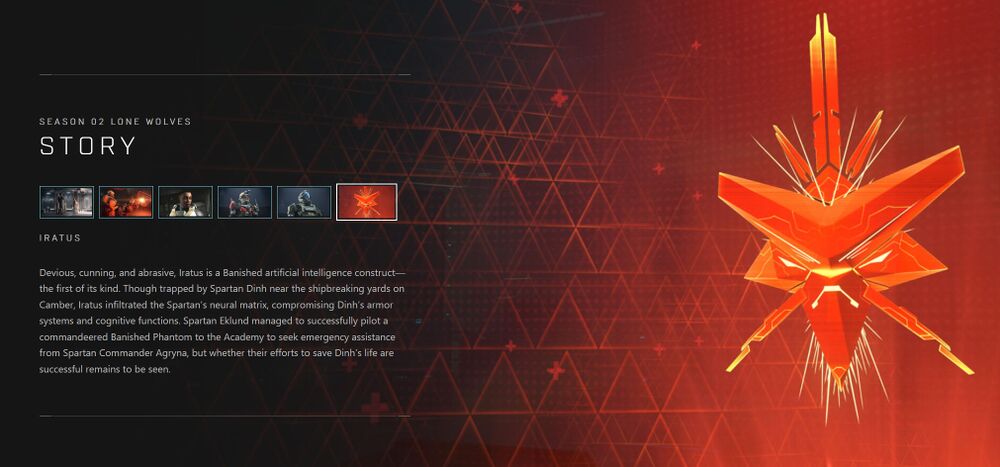
With this new season bringing both new characters and new story elements to Halo Infinite, you can head over to Halo Waypoint's seasonal story hub to learn more about the characters and events of Season 2.
Another great thing that you'll find here, which fiction fans will definitely want to keep an eye on, is the INTEL section...
Similar to data drops done in the past, this is where you'll find excerpts of conversations and communiques providing some background lore for the goings-on in the seasonal story. The first has already gone up.
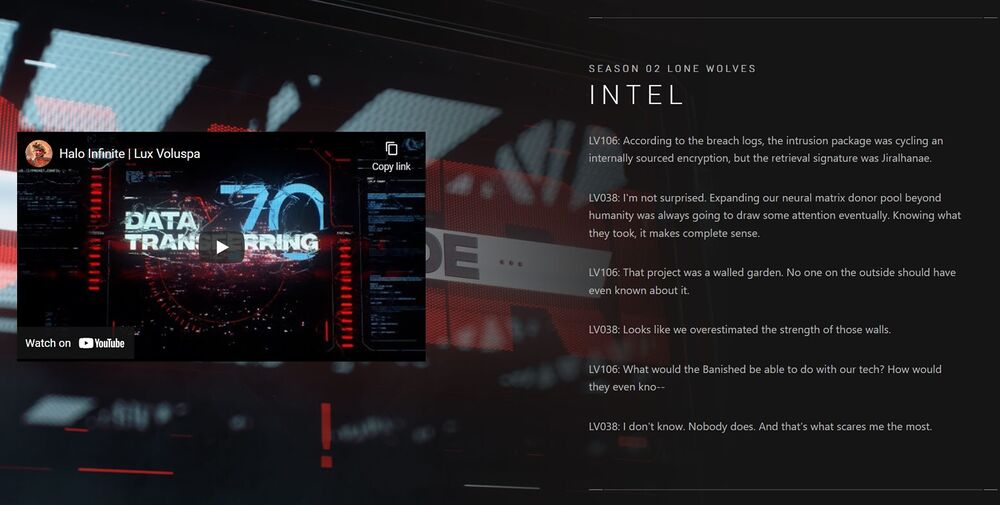
Lone Wolves, A History[modifier le wikicode]
The term is one that has something of a storied history in Halo itself, going back to Halo: The Fall of Reach in 2001.
Halo: The Fall of Reach, p. 59
In his journey to becoming the leader of the Spartan-IIs, John-117 learns that it doesn't matter if he finishes first—if his team finishes last, then he does as well. The wolf pack becomes an important metaphorical element of how the Spartans bond, recalling these lessons when they are out in the wild.
But even as Spartans are taught to function within the dynamics of a team, some of them have a particular proclivity for operating by themselves.
Halo: Reach is an obvious go-to example for this, where Noble Six is told by Carter-A259 to “leave that lone wolf stuff behind” at the start of the game, alluding to the operations that S-B312 has undertaken as something of a “private grim reaper.” Indeed, much of the campaign is spent fighting alongside Noble Team, but the missions Exodus, New Alexandria, and (fittingly enough) Lone Wolf have Six making their way through a Covenant-occupied city by themselves. And at the end of the game, Six is the last Spartan standing against an onslaught of Covenant forces who bring the Spartan's journey to its end.
The other major example is the comic series Halo: Lone Wolf, which released over the first four months of 2019.
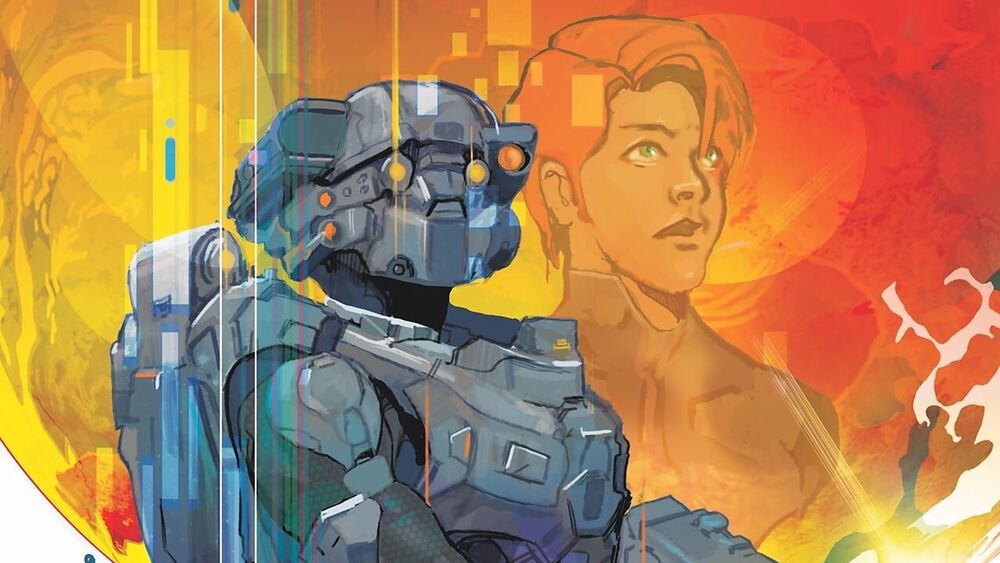
Due to her infiltration and marksmanship skills, as well as her detached demeanor, Linda-058 is deemed to be the perfect Spartan to be sent on an assassination mission in 2553, about a year after the end of the Covenant war. Now that humanity has emerged victorious, ONI is looking to tidy up some loose ends after Dr. Chen, a rogue scientist who seemingly went missing during the fall of Reach, resurfaces with something immeasurably valuable in his possession: Gabriela, the AI that contains an archive of all of humanity's known history.
Throughout this story, however, Linda leaves the ONI AI she's paired with greatly confused as she complicates her mission by not simply executing Dr. Chen. Linda is herself disenfranchised with the speed at which humanity has gone back to fighting itself after the Covenant war brought them to the brink of annihilation and chooses to put saving the lives of the colonists over killing their leader.
Each iteration of this concept has brought a new angle to how these stories are articulated, and now, in Halo Infinite, we're returning to it as a seasonal theme.
Given the current state of the galaxy, this was a particularly compelling idea to explore in a story where the stakes are high but the scale is relatively smaller. Much of the UNSC infrastructure that we typically take for granted has been upended. Soldiers have been cut off, trapped behind enemy lines, and so what does it look like when Spartans—these symbols of hope—are put in the same boat and forced to scavenge to survive just another day? What happens when they find something dangerous out in the wild and they bring it back to the one place Spartans have been able to call “safe” harbor?
Maptaculore, The Third[modifier le wikicode]
I've always found that Halo maps felt like living spaces in the universe, they all have some kind of story to them, they don't just exist as a space to shoot other players (though you certainly do a lot of that!)
For this issue, let's take a closer look at one of the new maps arriving with Season 2.
BREAKER
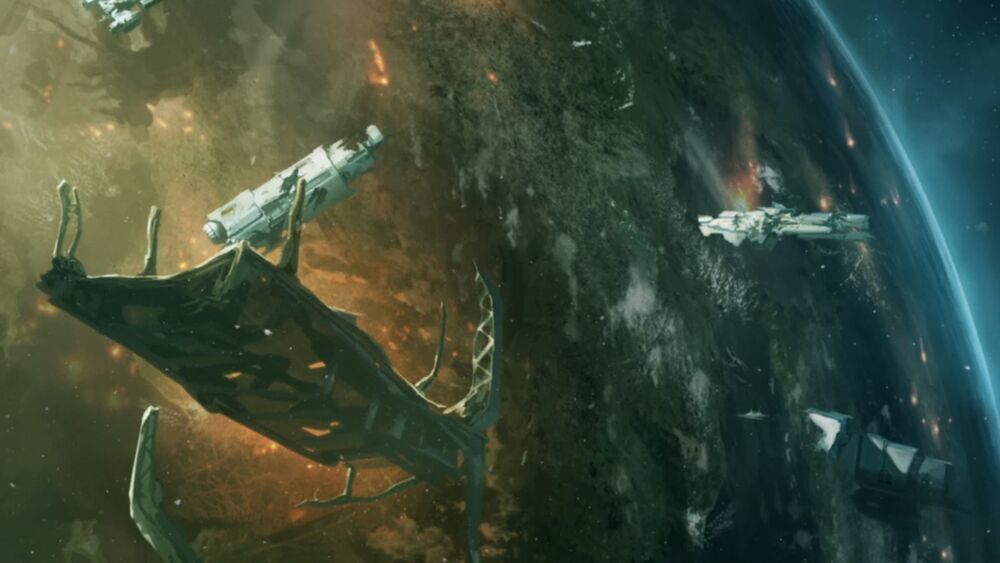
Lt. Commander Jameson Locke (Halo 2: Anniversary, Terminal 2 - "ONI File: Honor Bound")
The colony world of Camber was settled by humanity in 2522, just a few years prior to first contact with the Covenant which would lead to a war that brought humanity to the brink of annihilation.
Hostile attention was drawn to Camber as early as 2542, where initial Covenant strikes were directed towards targets of strategic value, such as its UNSC fleet depots. These preliminary attacks set the stage for Supreme Commander Thel ‘Vadamee, who led the growing Fleet of Particular Justice to Camber in 2546 for a decisive assault on the UNSC headquarters.
The subsequent glassing rendered large swaths of the planet desolate, though its atmosphere remained intact, resulting in volatile changes to its climate and frequent storms.
In the years that followed, the Banished moved in and overtook several of the UNSC assets that had been left behind. There, they did what they do best: refit and repurpose these salvaged ruins into tools to serve their needs. Establishing an expansive ship breaking yard to melt down titanium with a powerful plasma drill, the Banished reforge these monuments of failure into a new set of teeth and claws to tear at the throat of their enemies.
It is here that Spartans Hieu Dinh and Sigrid Eklund were on a recon operation, prior to their eventful arrival at the Avery J. Johnson Academy.
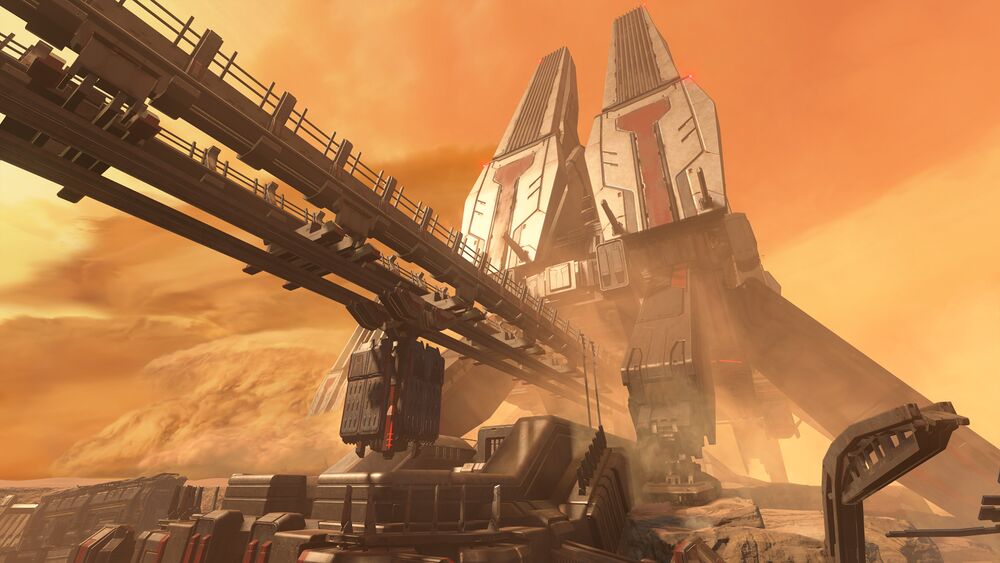
Eaglestrike[modifier le wikicode]
Season 2 of Halo Infinite introduces players to a new Fracture armor set that—like the YOROI armor core of Season 1—puts a unique alternate-universe spin on the Halo universe.
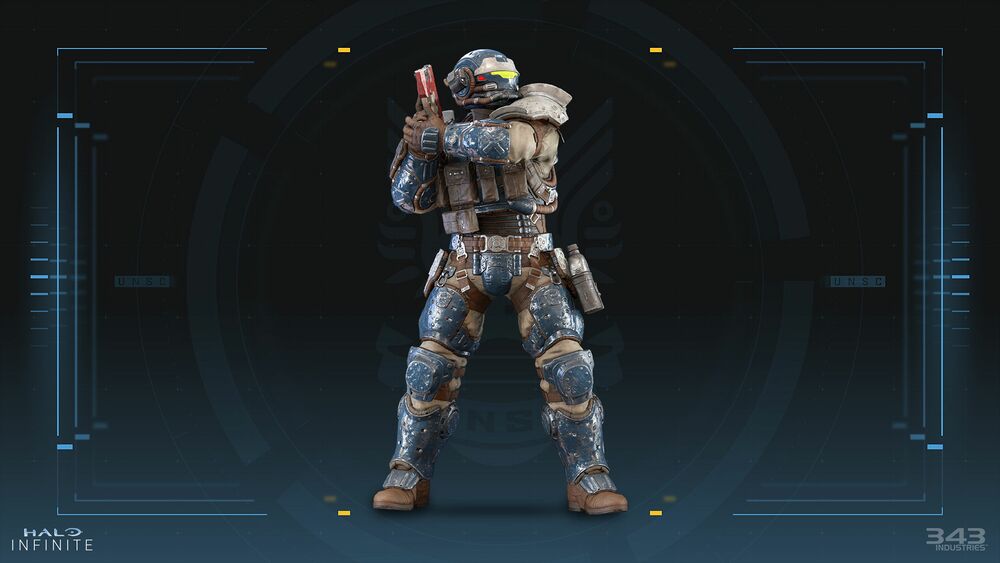
The Entrenched Fracture is a world scoured by superscience aether-bombs and alchemically-enhanced soldiers. Though its lands are ruined, the Unified Nations Security Confederation fights on in blind obedience to orders from long-dead generals.
Their sworn foes, the zealots of the Covenant, survive only as hordes of rad-poisoned mutants bickering over the remnants of their once-proud civilization.
Survival on the front lines requires EAGLESTRIKE energized plate, a marvel of war-smithing that protects against both radiation and Covenant plasmatron weaponry.
Pondering Poetry[modifier le wikicode]
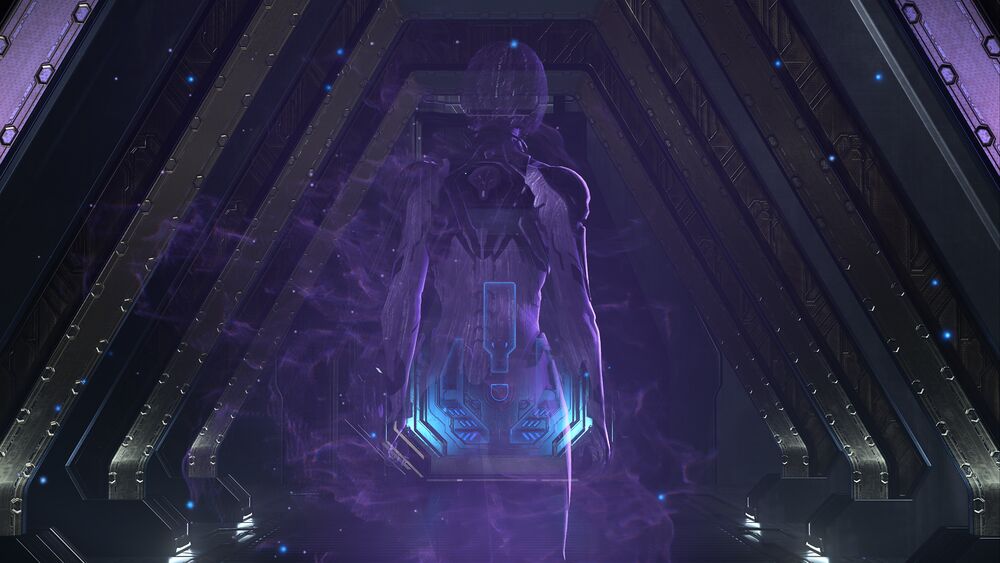
For this issue's analysis section, we're joined by Dan Chosich (Narrative Experience Director) to talk about poetry (yes, really). Poetry has, after all, been a part of Halo in numerous ways over the years.
The Gravemind speaks in a poetic meter; the Writ of Union that united the Sangheili and San'Shyuum was articulated as a poem; the cadets of Corbulo Academy would see the poem “Forward Unto Dawn” inscribed above their beds, making it the last thing they would see before falling asleep and the first thing upon awakening; and poetry has also featured in other expanded universe media as well, with notable examples being uniquely written poetry in Halo: Evolutions and Fractures, and Halo: Hunters in the Dark contains an epigraph in the form of a stanza from William Cowper's “Retirement.”
Perhaps the most notable example of poetry that has resonated in the memories of long-time players is from T. S. Elliot's “The Hollow Men,” quoted by Cortana.
“This is the way the world ends.”
In Halo Infinite, keen-eared folks have picked up on a few different poems and texts that are spoken by Cortana throughout the campaign: “Eidolons” by Walt Whitman, “Out Beyond Ideas” by Rumi, “Waking” by Aldous Huxley, and parts of Virginia Woolf's final note before she took her own life.
Let's throw it over to Dan and dig into the role these poems play in telling Halo Infinite's story...
DC: The game and announcement trailer where I remember the poems the most was Halo 3. They were evocative to me for several reasons.
The language was beautiful, powerful, emotive, and intriguing. Why is this ‘the way the world ends'? What does that even mean? Is ‘the world' the entire world or merely your own existence? Questions like that are staples in the design of Halo. How much can you see? How much do you know? What do you believe and how can that belief propel you into the unknown?
Practically, how do you bring in the feeling of a working, evolving world whilst playing in corridors? Good Halo design is good game design. That means not telling players what to feel but causing players to put themselves into the space and draw their own conclusions.
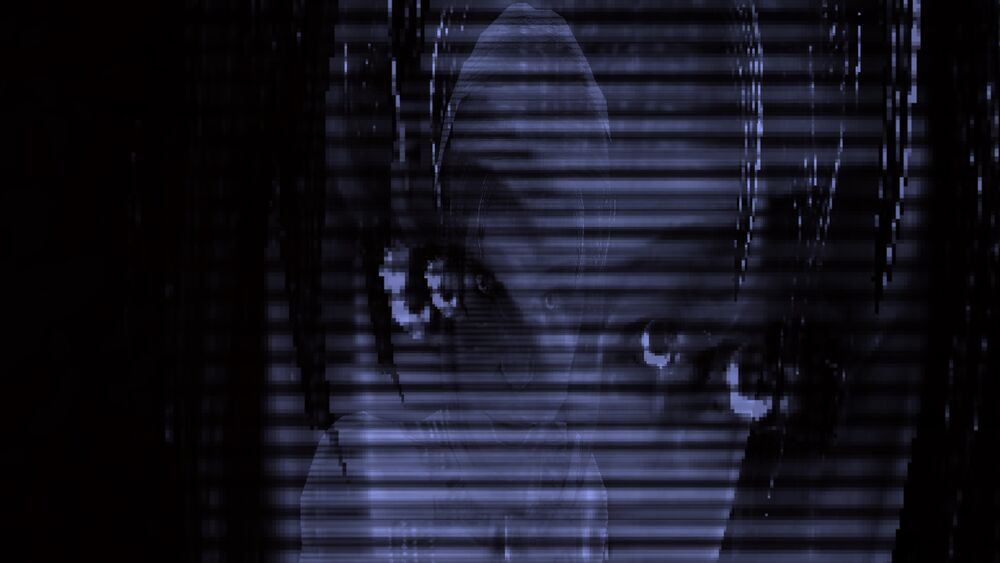
AW: I think that's such an evocative point, about not “telling” players what they should be feeling, because everybody has a fundamentally different experience. I think back to Halo 2, where the Arbiter confronts Tartarus in Delta Halo's control room, and that moment of hesitation that Tartarus has when the truth about Halo is revealed... it happens in a second, but it can fundamentally change how you look at that character.
DC: I come at things from my own experience being a fan who was not necessarily mired in the fiction initially, but was enamored more with the feelings the games espoused. The feeling the poems gave me in Halo 3 were more like distress calls. Disregarding the gameplay delivery mechanism of slowing the player down to deliver the message, it was a moment of reflection. The way I always took it was as a deliberate downbeat; it was as an arbitrary neuron firing and eliciting the utterance of a random memory. It's a death rattle mixed with beautifully reflexive prose.
The poems acted as a bridge in my mind where language takes on a different connotation. It's almost like song, or like saying, "I'm not going to tell you how I feel, I'm going to sing it to you." There's a deeper emotional impact because, again, it leaves space for the player to put themselves into it. Exactly like music; it exists to inspire reflection, connection, and it no longer becomes Cortana's journey exclusively, but all of ours—it's deeply entangled with the feeling of entropy and longing.
AW: I'm always fascinated by the production side of things for ethereal stuff like this. The words on the page are one thing, but bringing it to life, giving it that sonic resonance—how did that come together?
DC: They were all recorded with a binaural microphone. This meant that we recorded it on the same stage that we shot the mocap. A binaural microphone looks like a human head. That human head became a proxy for the player. The audio team then used an array of mics to capture Jen Taylor as she circled this head with her body, moving in and out of the microphone's inputs. This created a whirling, ghostly effect that we used and overlapped to create the feeling of whispers, with the intent of that feeling being that Cortana is almost like a phantom limb for the Chief.
A natural parallel one might draw here is with Hellblade: Senua's Sacrifice from Ninja Theory. Kiki Wolfkill and I got a chance to sit down with Ninja Theory to explore their approach. We had been looking at a lot of different examples of how storytelling was evolving in VR and Ninja Theory's was absolutely fascinating.
A lot of it had to do with the audio. A camera pushes down an open-world path, circles around Senua, a tree burns while Senua emotes directly to the player. The sound whirled around you and panned interestingly between both ears. It was a stunning piece of work, and it reinforced this unspoken contract of intimacy between the player and the character.
Hellblade shipped with these moments, told in a different way but with the same methodology, and we were really inspired by that. You may notice a similar approach taken with both Cortana and Escharum, the latter only happening in very select moments.
Final fun fact about audio, the entire ending speech of the game is played during the second level, Foundation. It's backwards and phases in and out of the ambience as you traverse the ring's underbelly. We wanted the game to have this symmetry with the beginning and ending—and we put it in the second level to act as an Easter egg and spiritually suggest that in some ways Cortana has always been trying to reach out.
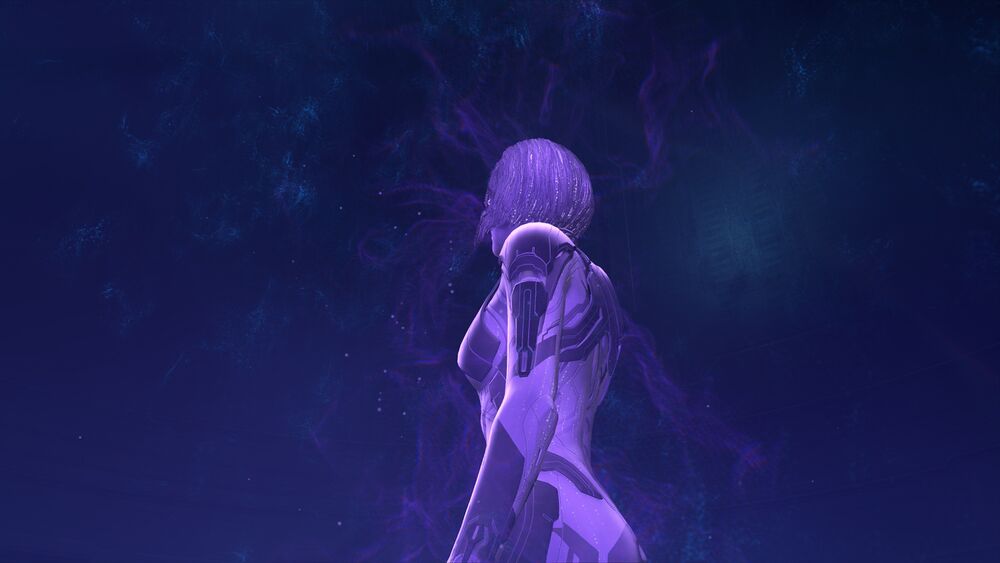
AW: That is amazing, I didn't even know that! That can absolutely join the hall of fame for reversed messages in Halo, like the ones found in Halo 2’s Mausoleum Suite and Halo 3’s Black Tower and Dread Intrusion. What was it about some of these poems in particular that made them perfect for the game?
DC: The Rumi poem was picked because the wall of my therapist's office displayed that quote: “Out beyond ideas of wrongdoing and rightdoing there is a field…” - the idea always meant to me that it's a plea to find sort of safe space and common ground, to slow down and keep an open mind. I think there's a lot of depth and beauty in that concept. Take this all in. This is not about how fast you can shoot each other. It elicits a sense of deeper passion built into the walls.
The Virginia Woolf note was used because I played it repeatedly while working. Max Richter has a song called “XVI. The Waves. Tuesday” narrated by Gillian Anderson. Audibly, waves crash against a shoreline while Gillian Anderson reads the poem. Strings slowly undulate with the crashing waves. The poem is a letter to a loved one explaining that, with all her diminished faculties and mental frailties, she feels she's robbing her loved one of joy. There is life to be experienced, therefore she will take herself out of the equation if that means her partner can feel the freedom of life without restraint.
The waves represent this unyielding force—like seeing a mountain and knowing it has existed long before you and will exist long after you. The waves act as a constant in a ‘sea' of variability, yet at the same time reinforce a universal truth that humanity will overcome and be resilient. No matter what, you'll make it through because you've gotten this far. It's a letter of admission and hope.
AW: And that, really, is the core thematic premise of the series in a lot of ways. “Hope” can be a very broad term, and I think that really takes it to a much more personal and relatable level.
DC: All the poems represent variations on these ideas. The good that once existed, the desire to reach out and touch the next frontier, the storm that approaches, the randomness of memory, the deep seeded hope that can only come from time, perspective, and forgiveness. It's all these things that are universally resonant with the player during downbeats of gameplay.
And maybe none of it lands, but it's an earnest desire to give the game a deeper foundation that squarely includes the player in the journey. Constantly asking “does this make me care, wonder, and reinforce the overall experience?”
And that was a core question when it came to using these pieces: does the poem speak to a larger theme, moment, or beat that feels in-line with what Cortana was going through as she made the choice to sacrifice herself?
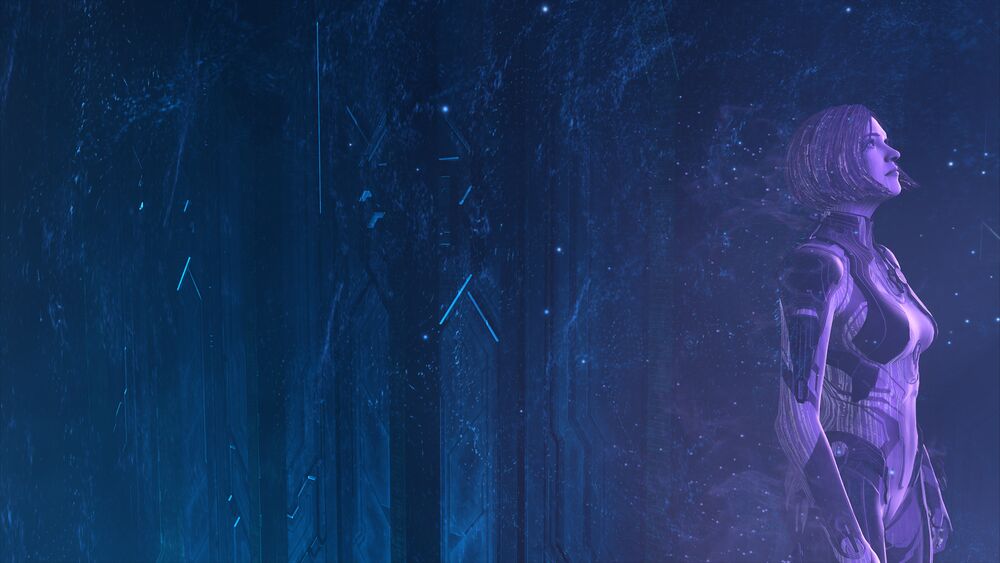
AW: Music seems to be a big influence here, and I think the way we think about how music flows offer some interesting parallels to how gameplay in a first-person shooter functions in some ways...
DC: The poems serve a practical use. If you were to look at a level from a top-down perspective, they bounce between several experiences that are akin to music. Music has dynamics. Downbeat and upbeat tempos that create this feeling of rising/falling action, progression, tension, whatever. Games have that too.
Something happens, then the level design, sandbox, or story poses a question or mission. Proceed forward with your newly acquired mission and use your knowledge to piece together the path forward. The path forward can be puzzles, combat, a story beat... What we found early on was that the poems acted as a good bridge between the mission, the puzzle, and the objective.
The poems were an abstraction that aided in this feeling of life being in the walls of Zeta Halo. The entire ring is imbued with Cortana, and you must figure out why that is.
The abstraction became interesting was because it invites the player to think outside of the mode of shooting. Abstraction elicits questions. Questions are at the heart of good sci-fi: why are we here, where are we going, what does all this mean? That's the reason working in a sci-fi setting is a gift. And hopefully we're saying something with meaning that helps the player understand some part about themselves better.
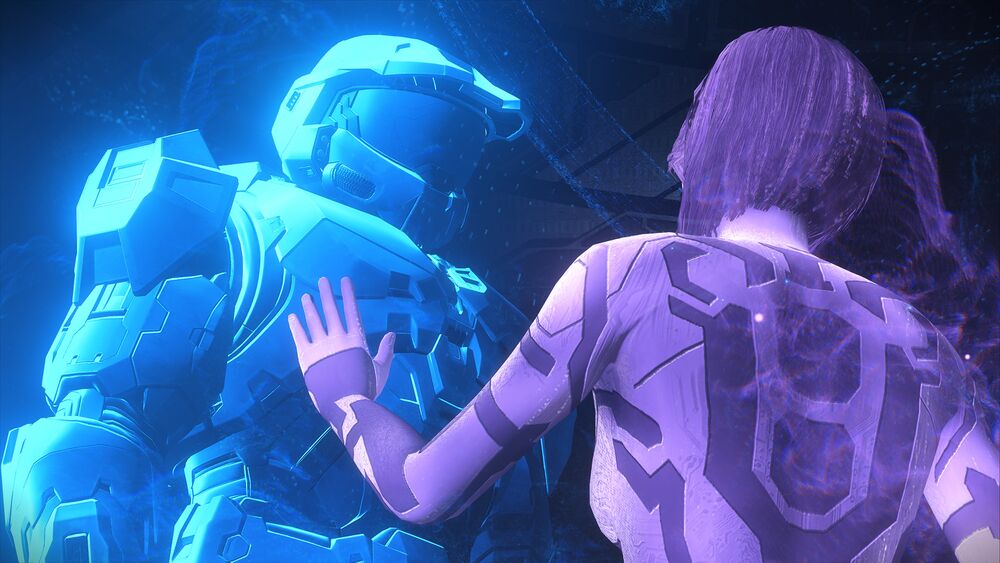
AW: Thank you very much for your time and perspective on this, Dan. I wish we could keep going for another ten thousand words, but alas I must let you pass back into the Domain—for now...
As a bit of a post-script, the way the Master Chief deals with Escharum is something that has some interesting parallels with Cortana (which could be another ten thousand words unto itself, but that is for another time). As the Weapon wonders why Escharum is making such a point of telling the Chief about his renewed sense of purpose after the razing of Oth Sonin, the Chief understands that death is something that changes people and Escharum made the same choice that he would—to fight to the bitter end.
In the end, the Chief sees Escharum as a soldier—somebody who was hoping he'd done the right thing, questioning the choices he'd made. Yes, he was a monster, but were humanity in the same position as the Banished, how different would their actions be? What terrible things are we capable of doing—be it in the name of survival or otherwise? The answer to that question for the Master Chief could be found in a mirror...
An Update on Halo: Outcasts[modifier le wikicode]
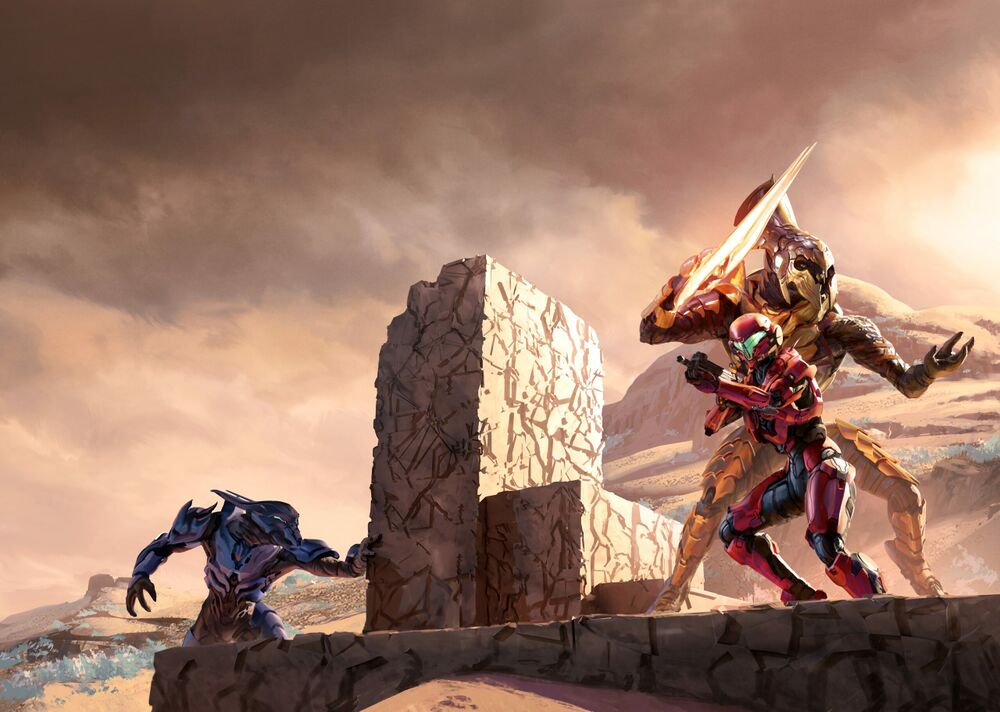
We recently revealed the cover art and official description for the upcoming Halo: Outcasts novel by Troy Denning, featuring Arbiter Thel ‘Vadam and Spartan Olympia Vale on the cover as they return to Netherop in 2559 to search for an ancient alien artifact that could turn the tide against the Created threat.
While originally slated for release on October 18 this year, the timeline has currently been adjusted to release in 2023.
In the meantime, we still have Halo: The Rubicon Protocol coming in August, new narrative elements in Season 2 of Halo Infinite, and a plethora of lore content to continue to break down and discuss in our monthly Canon Fodder issues...
And with that, we come to the end of another issue.
Next month will be a full encyclopedic extravaganza, so do keep an eye out on your community spaces for any new prompts for upcoming Q&A segments and that sort of thing.
Enjoy Season 2, treat yourself and go read some poetry, and May the fourth be with you!
And thee my soul,
Joys, ceaseless exercises, exaltations,
Thy yearning amply fed at last, prepared to meet,
Thy mates, eidolons.